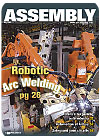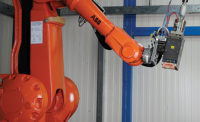
To get an idea of how well six-axis robots can save money and boost productivity in an arc-welding application, engineers need look no farther than a system for assembling irrigation pipe that was recently developed by Motoman Inc. (West Carrollton, OH).
The diameter of the pipe ranges from 6 to 8.6 inches, and the lengths range from 19 to 38 feet. The application called for holes to be cut into the pipes at various locations. Then, flanges, couplers and brackets had to be arc-welded in place.
Motoman worked out a 10-robot system to do the job. Two robots load the pipe and flanges into fixtures, and weld the flanges in place. A second team of four robots uses plasma cutters to make the holes and grippers to position the brackets. Then, a third set of four robots welds the brackets, while the second team welds the couplers. When the pipe is fully assembled, the first team unloads it, and the process starts all over again.
"The system can process a 38-foot pipe in 2 minutes, 3 seconds," says Tim Luneke, senior application technician at Motoman. "That's pretty impressive. Almost every robot in the cell does at least two tasks."
Almost since robots were invented, welding of one sort or another has been the No. 1 application for the technology. Today, arc welding accounts for approximately 20 percent of robotic applications, and it's not hard to see why. Robots weld faster and more consistently than people. They work 24 hours a day, 365 days a year. And, they can't be injured by weld spatter or fumes.
Indeed, if you ask Anthony Zarb, key technology manager at Kuka Robotics Corp. (Clinton Township, MI), when assemblers should use six-axis robots for arc welding, he'll give you a one-word answer: "Always."
For Zarb, that's more than just a pat answer, it's a prescription for keeping U.S. manufacturers competitive. "If you don't want to learn how to speak Chinese, you had better learn how to automate," he says. "I would always use a six-axis robot for arc welding. A robot is future-proof. There is always residual value in a six-axis robot."
Six-axis robots can be used with any arc-welding process: gas-metal, gas-tungsten, plasma and hybrid laser. Robots can be used to weld steel, aluminum and chrome-nickel; large parts and small parts; light welds and heavy-deposition welds. Arc-welding robots can be justified for both low-mix, high-volume assembly and high-mix, low-volume assembly.
In the automotive industry, arc-welding robots assemble numerous components, including chassis, body frames, exhaust systems, axles and door latches. Case New Holland (Fargo, ND) uses six-axis robots to weld the 4,000-pound chassis for wheel loaders. Deere & Co. (Moline, IL) uses arc-welding robots to assemble steel frames for skid-steer tractors and the steel decks for commercial lawn mowing equipment. Trutzschler GmbH & Co. (Monchengladbach, Germany) uses six-axis robots to weld steel drums for textile carding machines. A medical manufacturer in Ohio uses arc-welding robots to build steel and aluminum frames for wheelchairs.
"Robots are extremely versatile," says Luneke. "Robots can do half-inch welds or welds 12 feet long or more. We might need more than one robot, but we can weld any size part."
Anatomy of a Cell
Any six-axis robot can be outfitted for arc welding. However, some suppliers have designed robots specifically for arc welding. "The difference between a standard arm and one that has been designed for welding is that the upper arm is hollow, so the torch and cables can go through it," says Luneke. "That makes it better for welding around circles. You don't have to manipulate the arm so much to accommodate the cables." Routing the utility lines through the robot arm also prolongs their service life.The size of the robot depends on the size of the parts to be welded. "For a very large part, like the frame for an off-highway vehicle, you might need a robot with a 3-meter reach and an 800-millimeter welding torch," says Mike Sharpe, manager of materials joining at Fanuc Robotics America Inc. (Rochester Hills, MI). "For a small part, like an automotive component, you might need a robot with a 1.4-meter reach and an 450-millimeter torch at a 45-degree angle, so you can get close to the part and weld around tight locations."
When specifying an arc-welding robot, engineers should consider their future needs, as well as their current requirements. "If the customer has the resources, I advise him to buy a robot with 12 inches more reach than he needs now," says Zarb. "He may not need it now, but he'll be making his cell more flexible. For a few extra dollars, you multiply the value of your investment."
Although six-axis robots have become faster, more accurate and more durable over the past few years, the most dramatic improvements in the technology have been in the controls. Programming an arc-welding robot has never been easier, says Sharpe. Engineers can now develop the weld path for the robot directly from the 3D CAD model of the assembly. A process that once required weeks with a teach pendant can now be done, off-line, in minutes.
"With a few clicks, you can create weld paths quickly and accurately, even for multi-arm applications" he says. "And, you're able to deal with issues like reach, accessibility and tool design up-front."
Besides one or more robots and their controllers, a robotic arc-welding cell contains a variety of equipment. Mounted to each robot are the torch, wire feeder, and supply lines for shielding gas, electrical power and, perhaps, cooling water. Also in the cell are the power supply for the welder, and an interface for communication between it, the robot controller and wire feeder. An automatic device for periodically cleaning the torch will prolong the life of the equipment and ensure quality welds. The cell must also have equipment to protect the operators, including perimeter fencing, flash protection, emergency stop buttons, and light curtains or safety mats.
Optional equipment includes:
- fixtures to hold the parts.
- a fume extractor.
- positioning equipment, such as a turntable, to take parts in and out of the cell. A well-designed positioner will enable operators to load and unload one set of parts while the robot is welding another set.
- a linear slide. When mounted to a slide, the robot can weld long parts or service more than one station.
- collision sensor. Mounted to the robot's wrist, this device protects operators and the torch from damage if the robot arm accidentally hits something.
- multipurpose gripper. This device enables the robot to swap torches, pick up parts, or use a grinding tool.
Because robots can weld faster than people, the arc welder will need a slightly larger power supply. As a rule of thumb, the power supply should provide 20 percent more amperage than would be necessary for a comparable manual welding operation. Some power supplies include an interface for the robot controller and are specifically designed for use with robots. However, some power supplies for manual welding will also work with a robot once the interface is installed.
"Some people...want to set all process parameters through the power supply, and the robot controller just tells it when to turn on and off," explains Luneke. "Other people want full control through the robot controller. And sometimes, the two devices share control over the process."
Like the power supply, the wire feeder should be designed to keep pace with the robot. To minimize changeover, the wire is usually fed from a drum or large spool.
The fixturing for robotic welding is critical. Even the most accurate welding robot will perform poorly if the fixture can't keep the parts in the same location time after time. The fixture should position the parts precisely and repeatably, and hold them securely in place throughout the welding cycle. The fixture should enable operators to load and unload parts safely and ergonomically, and it should not interfere with the movement of the robot arm. In addition, the fixture should be designed so that wearable parts can easily be replaced.
Alternatively, assemblers can opt to do without fixtures and use one or more robots to hold the parts while additional robots weld them together. This is a particularly good option for high-mix production or for welding parts that require a lot of articulation, such as automotive exhaust manifolds.
"Depending on how often your products change, you can save big money by doing away with fixtures, which can be extremely expensive for complicated parts," says Zarb. "Would it be better to spend $100,000 on fixturing, or $40,000 on a robot that you can reconfigure and use somewhere else?"
Ensuring Quality Welds
As with any automated process, success with robotic arc-welding depends on the quality of the incoming parts."If you can't control your process at the beginning of the cell, you can't control it coming out," says Luneke. "If you're welding stamped parts, they don't necessarily have to be accurate-they just have to be consistent. You have to send them to the robot the same way every time, because the robot can't always compensate for bad parts."
Fortunately, several technologies are available to help arc-welding robots produce quality joints.
One of those is touch sensing. In this technology, the robot uses the end of the welding wire to locate the parts in much the same way a blind man uses a cane to detect obstacles. When the wire touches the part, the controller captures the position of the robot, compares it with the programmed position, and adjusts the robot's path accordingly.
Another guidance aid is seam tracking. In this technology, the robot controller monitors the welding current provided by the power supply. If the robot is maintaining its programmed course along the joint, the welding current will remain constant. If the robot strays from the joint, the current will spike. Based on this feedback, the robot controller can adjust the arc length and arm position to keep the torch on the joint.
A third guidance technology uses a laser-based vision system to find and track the joint. However, because it's expensive, this technology is typically reserved only for the most critical assemblies.
Guidance technologies help, but they can't always fix problems caused by poorly fitting parts. Assemblers should expect reduced cycle times if the robot has to constantly search for joint locations on inconsistent parts.

